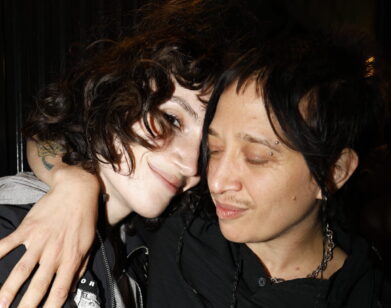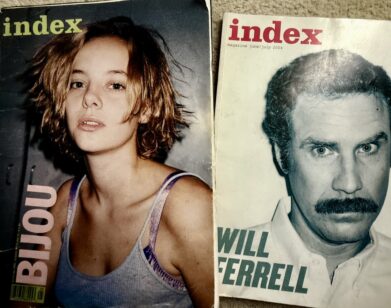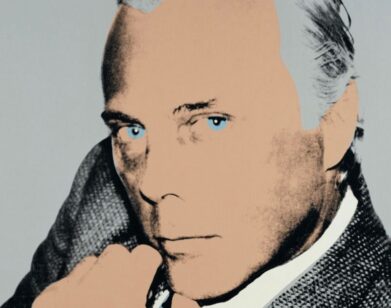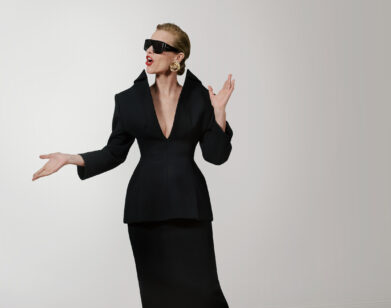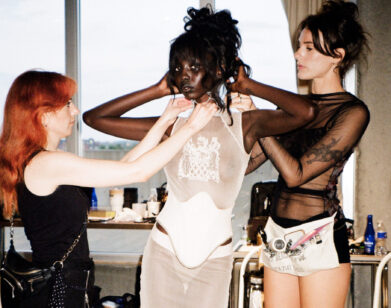Benz, Gurung, Goreski, and the Web We Weave
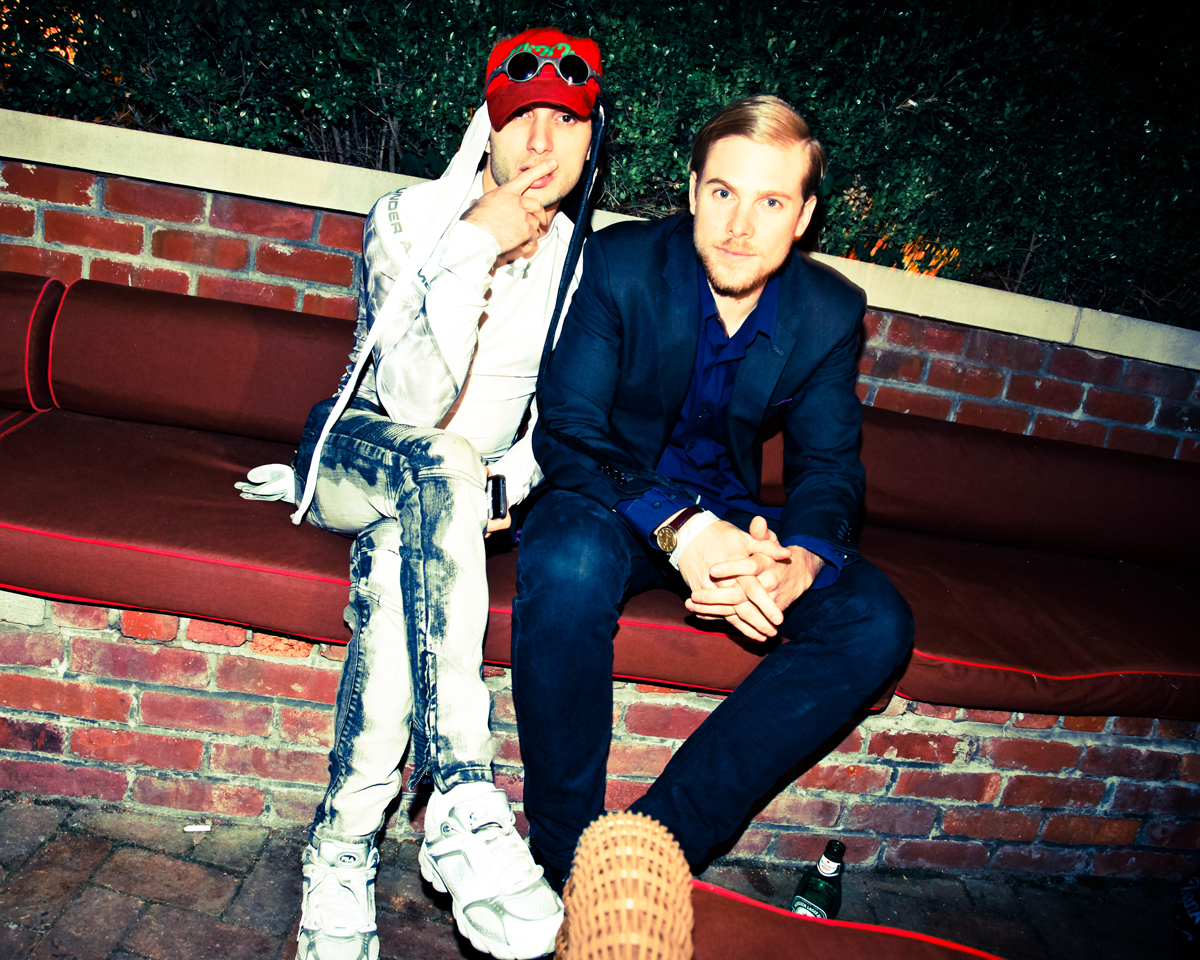
CHRIS BENZ, PRABAL GURUNG, AND BRAD GORESKI. PHOTOS COURTESY OF DAVID X. PRUTTING/PATRICKMCMULLAN.COM
Art, fashion, and music collided at the Bowery Hotel Thursday night, where designer Chris Benz and stylist Brad Goreski co-hosted Art Rocks! with Chair Nicole Berrie. The event, which included a digital art show co-curated by Emmett Shine and James Cruickshank, benefited The Naomi Berrie Diabetes Center at Columbia University Hospital. As DJ M.O.S. spun a mash-up of The Clash and No Doubt, Interview chatted with Benz about the influence of music on his design aesthetic.
Benz, who was wearing vintage Comme des Garçons (“I’ve had my eye on it since I was in college”), dyed his hair pink to match Goreski’s suit, because “Brad and I are good, old friends and I feel like in some ways we share a brain.” Benz is currently “busy working on Resort for the first week in June, and I’m also a mentor at Savannah College of Art and Design.” (Benz described his spring 2012 collection as “a spooky Savannah, a very dark and mysterious beauty, but a brighter version for spring.”) Benz, who interned at Marc Jacobs as a student, said, “I’m not that far out of school myself, so I feel like I have an empathetic position with younger artists and designers.”
“I grew up in the Pacific Northwest, where it’s all about being comfortable. I try to bring that undercurrent to what I do,” he continued. “It’s great to have beautiful, dressed-up clothes that still feel casual. I totally was into grunge, growing up. At the time, living in Seattle, we thought, ‘Oh, [Pearl Jam and Nirvana] happen with every generation,’ but of course, they didn’t. Everyone was shopping at the Salvation Army and vintage stores. Even the football players were wearing ripped tweed skirts! It was very strange. Everyone was in torn-up jeans and old cardigans. It was really cool. So in terms of design, we always like a little bit of an unfinished hem or a collar cut off. Grunge is a great playbook to riff off.”
RYDER RIPPS (LEFT) WITH EMMETT SHINE
Prabal Gurung, wearing a Patti Smith t-shirt and black leather jacket, hung out with Benz, his former Parsons classmate, while Sagya, a designer for Banana Republic and fellow Parsons alum from Seattle, said, “Growing up there, music and street art really influenced our fashion sense. We were more influenced by musicians than by fashion designers. The obvious being Courtney Love and Kurt Cobain and the street style being ‘fuck you’ and effortless. I have this image of Cobain in a grandpa sweater and Converses that he’d written all over.” Sagya, who interned at Daryl K, described the street art as “a lot of graffiti and outdoor sculptures. Seattle is so environmentally aware, which creates installations in parks. If it’s your art, it doesn’t matter what your canvas is.”
Johnny Weir’s canvas is his body, from head to toe. Weir was working his look at the party, from “M.A.C. makeup, Dior shirt, Arthur Galan jacket, Topshop shorts—can you believe it?” to emerald-green Christian Louboutin oxfords. “Mr. Louboutin is making my skates,” said the three-time U.S. National Champion and Olympic figure skater, who is currently “designing a Little Black Dress collection on edressme.com, and I’m skating, I’m training again, maybe to return to the next Olympics.”
Art Rocks! co-curator Emmett Shine views the expansion of the canvas from the wall and the street to the internet. “Skateboarders see a piece of concrete and turn it into something creative. Graffiti artists see a wall that nobody else is looking at and see it as a canvas. What is progressively cool about Internet art is it’s a limitless infinity; it’s a vector of a canvas. There are no boundaries to what you can create, which can be daunting.”
Shine’s company, LOLA NY, produces t-shirts and skateboards as well as organizing art exhibitions. “It’s a very DIY, skateboarding culture,” said Shine. “I also have a digital creative agency called Gin Lane, which produces websites, mobile apps; it’s deeply immersed in the Internet. Nicole wanted to take the uptown charity model downtown to a younger crowd. The last two years, we featured traditional artists. This year, I went to Art Basel and SXSW for interactive and I saw Ryder speak at the New Museum’s Rhizome interactive panel.”
Along with digital art by Andrew Kuo, Brendan Lynch, Austin Peters, Gordon Stevenson, Rene Abythe, Rafael Rozendaal, and Sterling Crispin, Ryder Ripps’ work was installed at the event. Ripps’ series of six computer-generated pinwheels denotes “time that you’ve lost online, a time suck. I spend 18 a hours a day on the computer.”
Ripps founded dump.fm, a site where people communicate in real time using only images (primarily animated GIFs) instead of words. Users “try to talk to the entire Internet, which is the summation of culture,” said Ripps. “Most artists, like the Abstract Expressionists, were about the inner; this is totally outer-focused. You are a conduit for expressing something that is happening in the ether of the culture. Computers are inherently Dada because they’re inherently a reappropriation.”
“It’s about reinterpreting the prior moment’s images, and [users] keep expounding upon a meme,” said Shine. “It’s like talking with emoticons, back and forth, just talking in crazy symbols. They will take a .jpg, add something to it, add motion to it, or text, or symbols—a conversation entirely in images. Traditional art is ‘figured out,’ while Internet-based art is forging ahead to a path which doesn’t yet exist, so it’s pretty cool to see people pushing boundaries on a daily basis. It’s really creative because people don’t know what’s going to happen tomorrow.”

